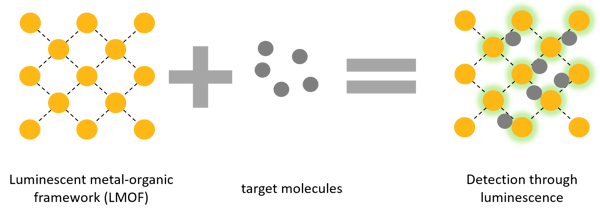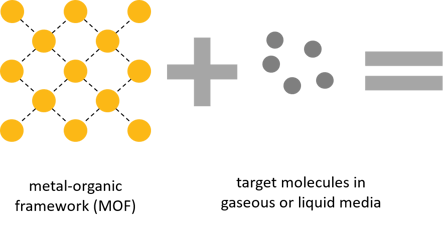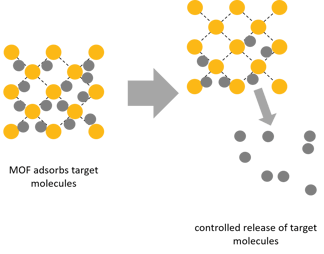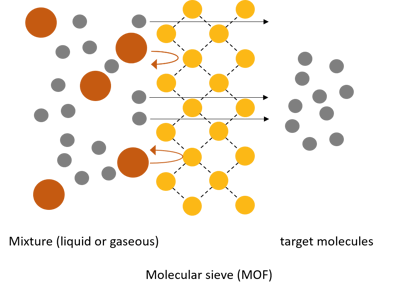Many industries rely on cleanrooms for a controlled environment in manufacturing or scientific research. Moreover, cleanrooms are designed to regulate the level of pollutants inside the rooms and securely contain hazardous substances at the same time. Find out, how metal-organic frameworks offer reliable solutions to multiple risk factors under these conditions!
Pollutants – dust, aerosols, trace amounts of chemicals or microbes – have to be reduced to a minimum as they could negatively affect the quality of products, performance of production or measurements. Besides the effect on the product within the room, cleanrooms further prevent environmental contamination outside of the room by keeping hazardous substances contained.
The size of cleanrooms varies as much as the industry they are used in. From small rooms to entire manufacturing facilities – from pharmaceuticals, life sciences or biotechnology to the production of semiconductors, LCD, LED or batteries. In other words, cleanrooms are used in locations that are highly sensitive to air condition and environmental contamination.
Controlled conditions through MOFs
All cleanrooms are based on a simple principle:
External air is filtered and led into the cleanroom, internal air is filtered and led out of the cleanroom.
Moreover, waste water needs to be cleaned of any harmful substance. Metal-organic frameworks have proven their great potential for filtration applications, yet they are not used to their full commercial potential.MOFs are crystalline materials that are highly structured frameworks of metal ions linked with organic molecules. The specific structure creates an enormous surface area – the surface of a single gram of MOF can be more than a football field. This creates room for physico-chemical reactions. In other words, MOFs can be compared with sponges, being able to take-up, hold and release molecules from their pores. Find more information on our page about MOFs.
We’ll dive into how these ‘sponges’ can be applied for cleanrooms in these topics:
- Keeping relative humidity in target range
- Detection of hazardous gases and vapour
- Capturing hazardous gases and vapour
- Particle filtration
- Cleaning waste water
If you are looking for more in-detail information such as air flow systems, classification and construction, you might want to have a look at the guide from IQS directory on cleanrooms.
Keeping relative humidity in target range
As the relative humidity (rH%) has an influence on metal corrosion, condensation, photolithographic degradation, static charge build-up, bacteria growth and water adsorption amongst others, it has to be controlled strictly. Low ranges of rH% increase the possibility of charge build-up on surfaces, while high humidity above 60% is favourable for the growth of biological contaminants such as bacteria and mould.
There are several options to control humidity in enclosed spaces. Metal-organic frameworks (MOFs) like MOF-801, PIZOF-2, MOF-74 and MOF-841 have shown great water adsorption capabilities within a specific narrow rH%-range. In contrast to silica and zeolites, MOFs take-up almost their whole adsorption capacity within the target rH%-range. That makes the humidity control perfectly predictable.
In an adsorption-desorption cycle, metal-organic frameworks have further proven to constantly take-up the same amount of water. The desorption happens at significant lower temperatures than silica and zeolites, which will consequently save energy and simplify application in air conditioning applications. Even passive water desorption is possible in some MOFs.
Find out more about water adsorption in MOFs in our case study:
Detection of hazardous gases and vapour
Some substances have great chemical properties in production but are toxic at the same time. Others have negative effects on production or measuring sensitivity. Detection/sensing and subsequent capturing of these in gaseous media are of high importance in any case.
Detection using luminescent MOFs
Luminescent metal-organic frameworks (LMOFs) offer great capabilities of sensing gases or vapour by reacting through simple changes in its luminescence. Depending on the LMOF, the detection will be shown differently:
- Emission turn-on: MOF lights up, when the target gas/vapour is around
- Emission turn-off: MOF usually lights up, but shows no light when the target gas/vapour is around
- Change of emission energy/wave length: MOF changes intensity or colour of luminescence in the presence of the target gas/vapour
 The detection properties can be tuned to specific chemicals by changing the building blocks (metals and organic linkers) of the metal-organic frameworks. The pore size in the framework can be tuned for simple size-based selectivity. Changing the ligand (linking organic molecules) will alter the physico-chemical properties of the framework. This allows to select chemicals by their chemical properties (e.g. separate specific molecules and detect others). The below list shows selected use cases of luminescent MOFs as detectors:
The detection properties can be tuned to specific chemicals by changing the building blocks (metals and organic linkers) of the metal-organic frameworks. The pore size in the framework can be tuned for simple size-based selectivity. Changing the ligand (linking organic molecules) will alter the physico-chemical properties of the framework. This allows to select chemicals by their chemical properties (e.g. separate specific molecules and detect others). The below list shows selected use cases of luminescent MOFs as detectors:
- Metal ions
- Cu2+
- Ag+
- Zn2+
- Cd2+
- Hg2+
- etc.
- Small molecule sensing:
- Aromatic compounds (toluene, nitrobenzene, aniline etc.)
- Acetone
- Nitro aromatic compounds/explosives
Another (not directly related application) are biosensors for the detection of DNA, ds-DNA and BSA (bovine serum albumin) and as contrast agents for MRI.


Electrochemical and electro-mechanical detection using MOFs
The ‘original’ MOFs show poor electrical conductivity as the metal ions are separated by organic linkers. However, tuning MOFs with additional materials can turn them into electrically conducting materials. This allows for electrochemical detection of various gases, vapour or substances in liquid media:
- Nitro aromatic compounds/explosives
- Nitro aliphatic explosives
- Pesticides
- Hydrogen H2
- Carbon dioxide
- Methanol
- Ethanol
- Pyridine
- Acetone
- Toluene
- Benzene
Other MOFs show electro-mechanical detection properties especially in liquid and gaseous media for target substances such as acetone, ethanol, hexane, toluene and benzene.
Subsequently, detected chemicals must be captured securely. Capturing in active carbon or other materials works very well for non-polar molecules. For the capture of polar molecules, MOFs have shown superior adsorption properties. Given the modularity of metal-organic frameworks, the adsorption properties are tuned to capture specific substances while others are left untouched. The large surface area of MOFs – 1 g can have a larger surface than a football field – makes them perfect for adsorption of unwanted molecules. Furthermore, adsorption works for gaseous and liquid media, which could be used for e.g. waste water treatment as described further down.
Target molecules include:
- Ammonia (NH3)
- Formaldehyde (HcHO)
- Hydrogen sulphide(H2S)
- COx
- NOx
- SOx
- Radioactive gases
Applicable MOFs used include amongst others MOF-74, SIFSIX-3-Cu, MOF-205 and MIL-101.
Once captured, MOFs allow regeneration of these substances in a following step. Depending on the metal-organic framework used, long-term stability over several adsorption-desorption cycles have been proven.
Particle filtration
Cleanrooms are graded according to the size and number of particles (between 0.1 µm and 5 µm) in a cubic meter of air. The fewer particles are found, the lower the ISO grade.
| Class | maximum particles/m3 | FED STD 209E equivalent |
|||||
| >=0.1 µm | >=0.2 µm | >=0.3 µm | >=0.5 µm | >=1 µm | >=5 µm | ||
| ISO 1 | 10 | 2 | |||||
| ISO 2 | 100 | 24 | 10 | 4 | |||
| ISO 3 | 1,000 | 237 | 102 | 35 | 8 | Class 1 | |
| ISO 4 | 10,000 | 2,370 | 1,020 | 352 | 83 | Class 10 | |
| ISO 5 | 100,000 | 23,700 | 10,200 | 3,520 | 832 | 29 | Class 100 |
| ISO 6 | 1,000,000 | 237,000 | 102,000 | 35,200 | 8,320 | 293 | Class 1,000 |
| ISO 7 | 352,000 | 83,200 | 2,930 | Class 10,000 | |||
| ISO 8 | 3,520,000 | 832,000 | 29,300 | Class 100,000 | |||
| ISO 9 | 35,200,000 | 8,320,000 | 293,000 | Room Air | |||
ISO 14644-1 Cleanroom Standards
To maintain particulate-free air in the cleanrooms, various filtering techniques such as EPA, HEPA and ULPA filters are used.
Metal-organic frameworks can be tuned to have specific pore sizes from a few Angstroms to a few nanometres, which can be used for filtration purposes in so called molecular sieving. Dust particles however are larger than single molecules. ZIF-67 has been used successfully to separate particulate matter PM2.5. However, the use of MOFs for such purposes might not be cost-effective and there are well-suited applications available. The benefit of using MOFs would be the adsorption of other molecules at the same time (such as formaldehyde in case of ZIF-67).
 Cleaning waste water
Cleaning waste water
Filtration for high-value or high-risk substances in a metal-organic framework can be a real value to the company as they show superior filtration capabilities to commonly used molecular sieves. Possible filtered molecules include:
- Heavy metal ions (Cadmium (Cd2+), Mercury (HG2+), Lead (Pb2+))
- Sodium (Na+)
- Chloride (Cl–) such as Calcium Cloride (CaCL2) and Magnesium Chloride (MGCl2)
- Dextran
- Rhodamine B
This is just a selection; the versatility of MOFs offers separation of many chemicals in order to reduce toxicity of waste water.
Why use metal-organic frameworks for cleanrooms?
At the bottom line, there are several applications around cleanrooms in which metal-organic frameworks outperform commonly used materials. MOFs can be tuned to sense molecules in various ways or capture, hold and release molecules in a controlled manner. This versatility makes them perfect to address specific requirements – one at a time or several together. Depending on the application, MOFs can be tuned to long-term cycle stability or controlled degradation.
For this article we used the following publications:
Metal organic frameworks for sensing applications
Luminescent metal-organic frameworks
Luminescent metal–organic frameworks for chemical sensing and explosive detection
Sensing and capture of toxic and hazardous gases and vapors by metal–organic frameworks
Metal–organic framework-based nanofiber filters for effective indoor air quality control
Metal–organic framework as an efficient filter for the removal of heavy metal cations in water
Metal-organic frameworks (MOFs) in water filtration membranes for desalination and other applications
Metal-Organic Frameworks for Sensing Applications in the Gas Phase




